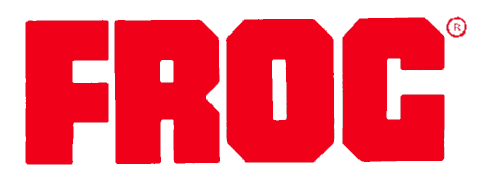
FROG Red Series F186 Lockheed P-38J/L Lightning, Rovex Industries Ltd, 1967
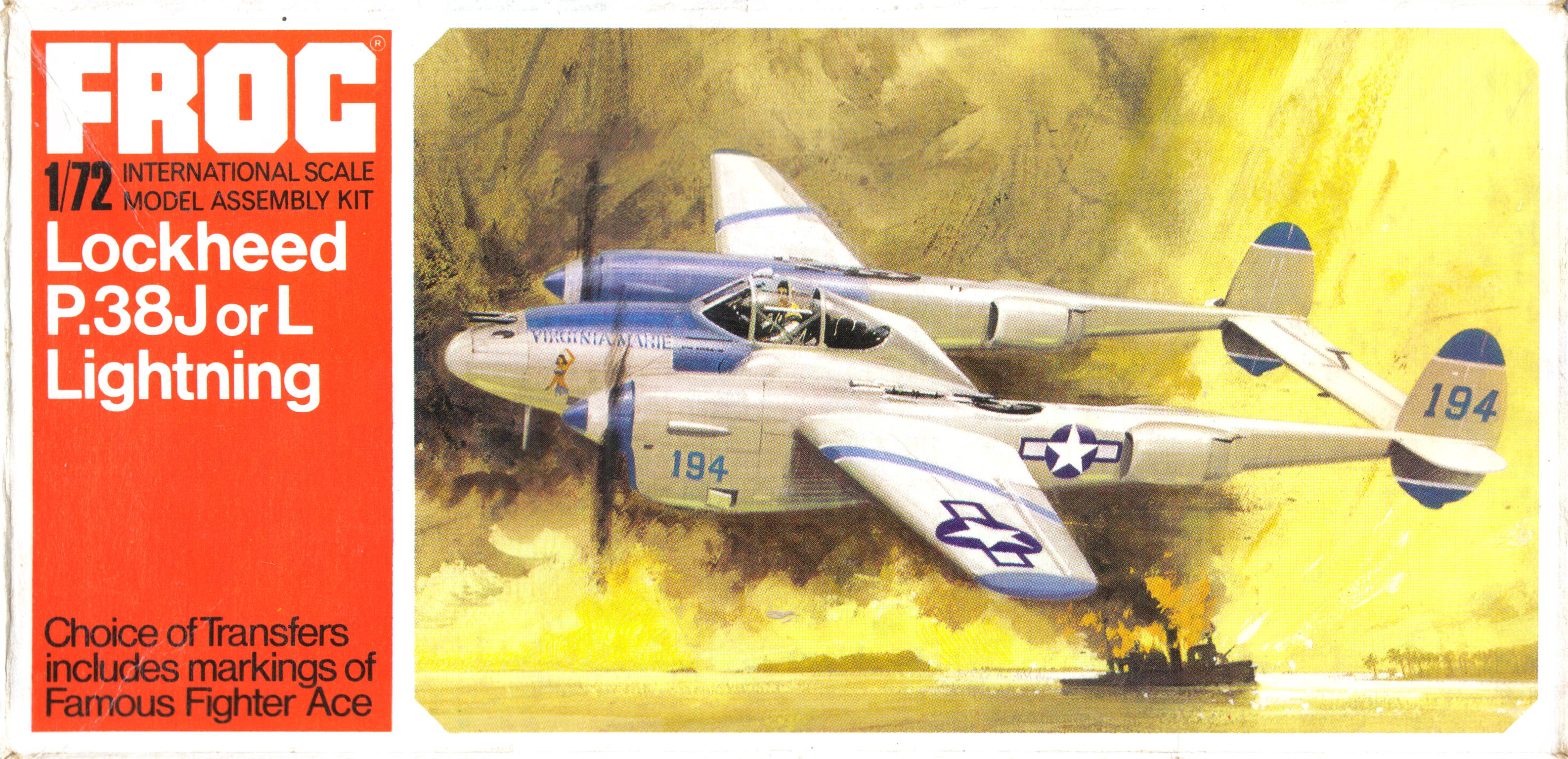
|
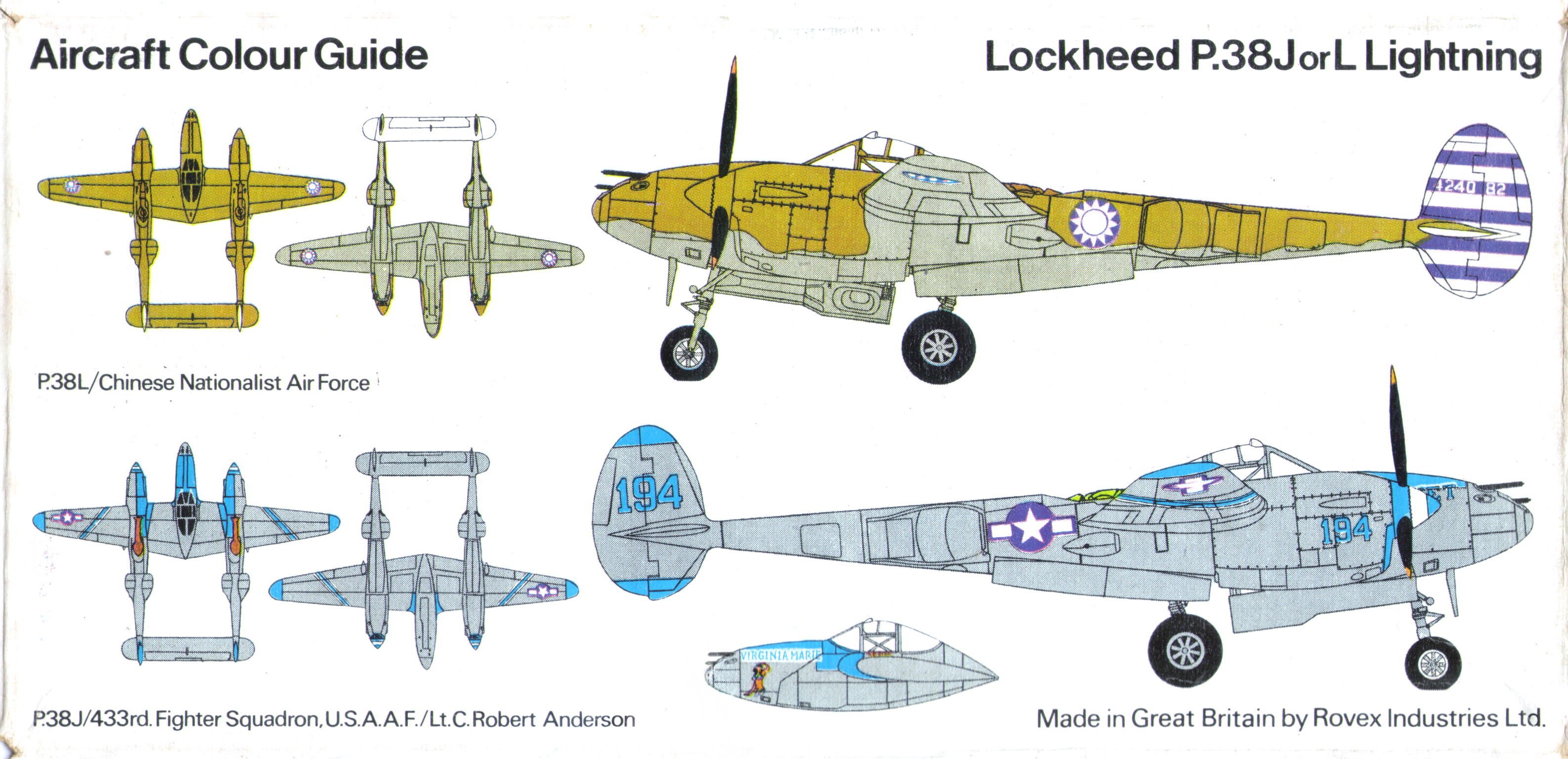




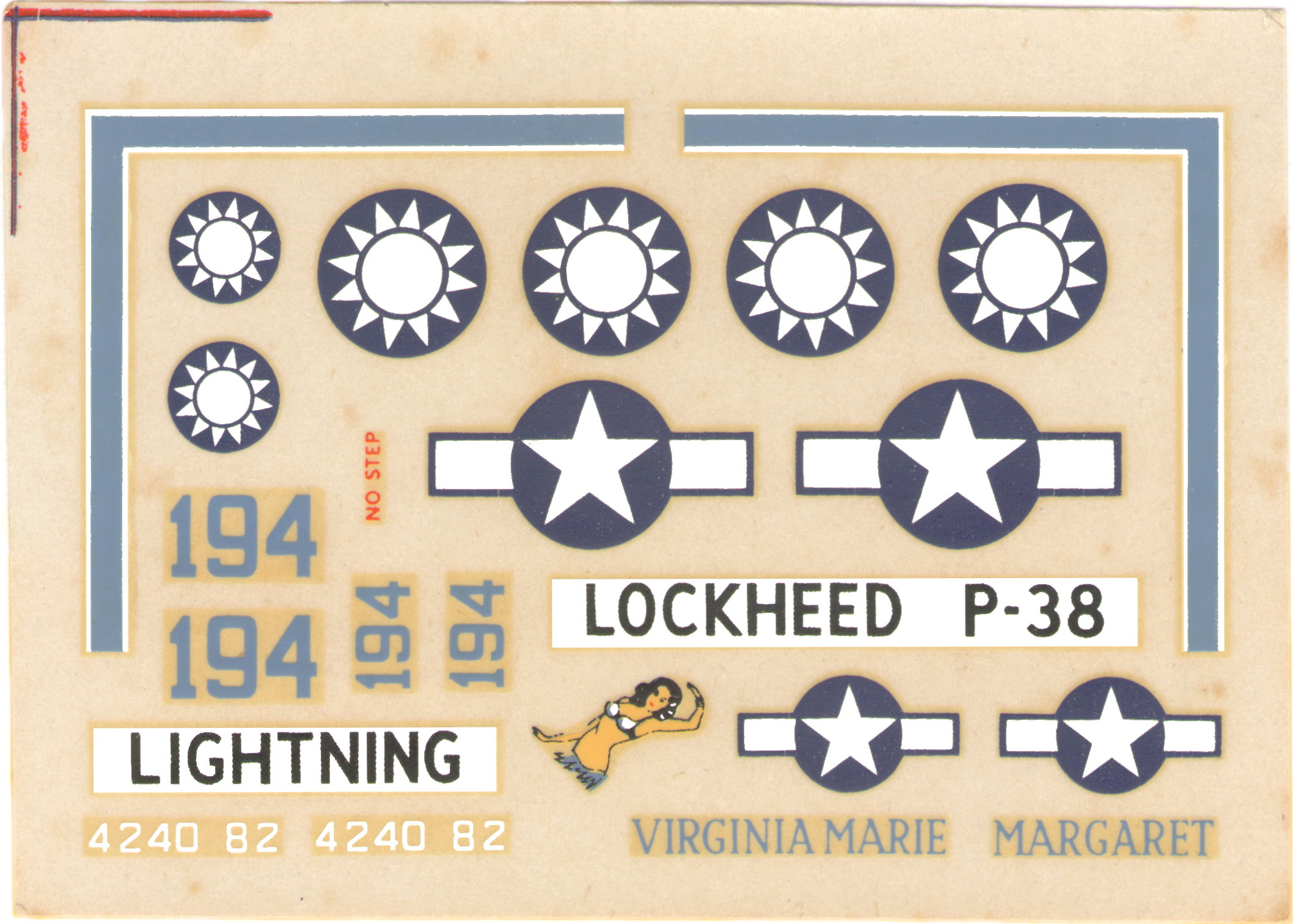
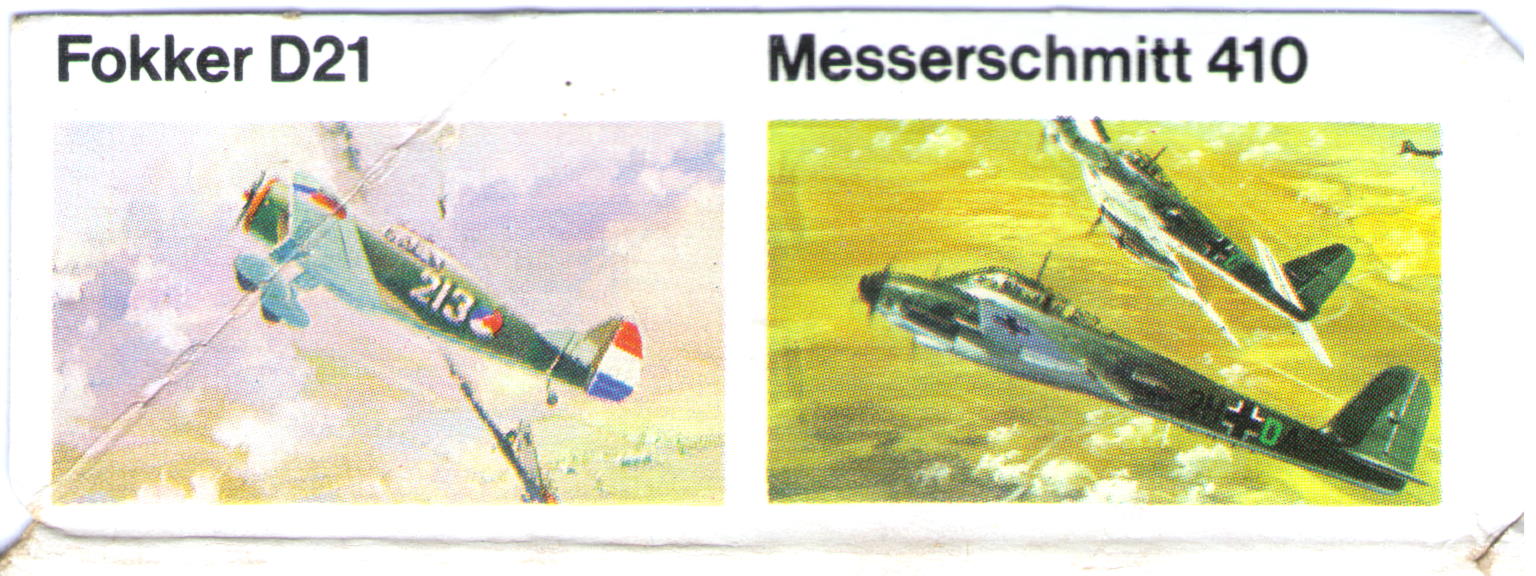
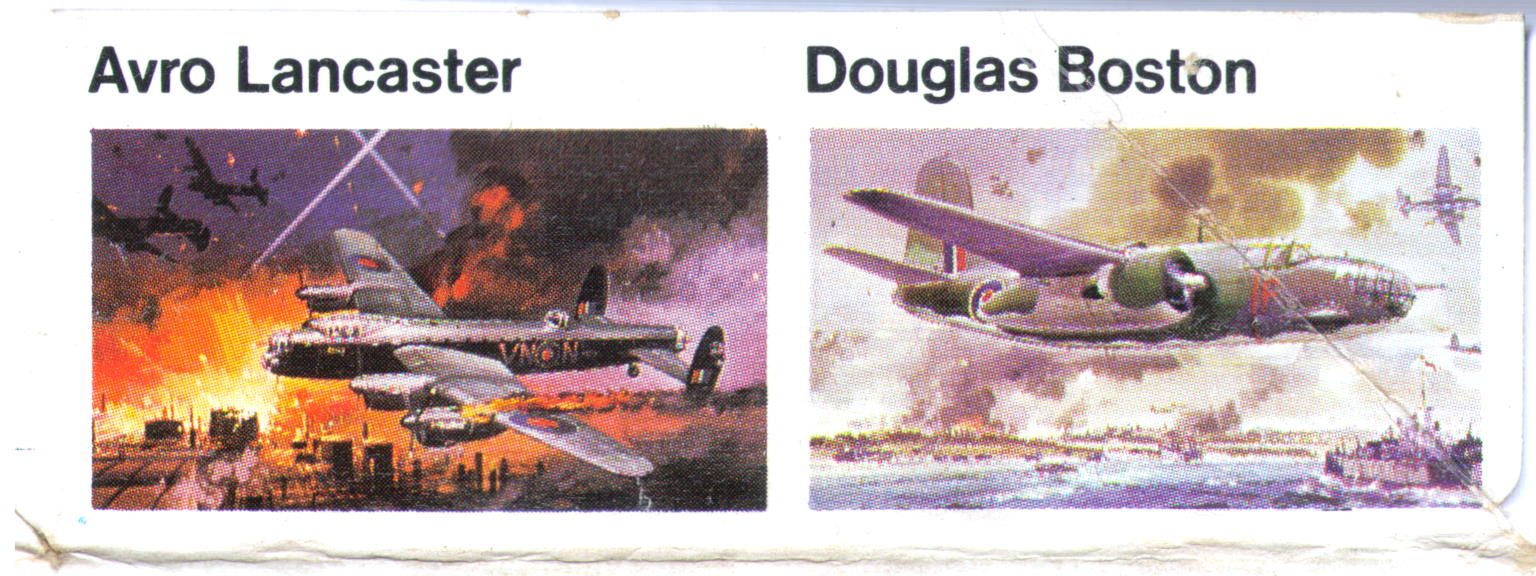
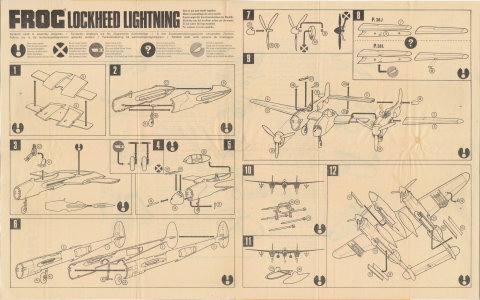
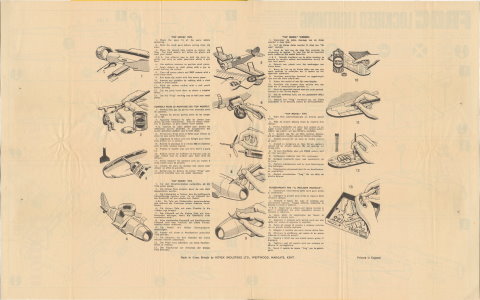
Lockheed P-38J/L Lightning
| F186 | 1967-1974 | G1(R) | 270 000 | 1xUSAAF & 1xNatCh AF |
FROG model aircraft 1932-1976, R. Lines, L. Hellstrom
|
|
NEW AND IN VIEW
AIRCRAFT KITS
FROG. Following the Shackleton will be a 1/72 scale P-38J Lightning, then a Lysander kit from which both the Mk. I and Mk. Ill agent dropper may be assembled. After this will come the Blackburn Shark on floats or wheels, alternative markings for both types being included in the kit. All these kits are due before or shortly after Christmas.
The IPMS magazine, Vol.5 No.10, OCTOBER 1967
NEW AND IN VIEW
NEW AIRCRAFT KITS
FROG. Lockheed P-38J and Lightening. 1/72 scale. Price 3/6d. (U.K.)
This kit is accurate in outline, but while the panel and rivet detail is acceptable, the overs ize rivet detail around the front of the engine nacelles will need to be sanded down. The model's appearance will also be improved by opening up the radiator intakes. The fit of the parts, which are pressed in light tan plastic, is excellent, while the unusual method of assembling them ensures that the model is easy to put together and rigid when completed.
The canopy is superb, very clear and of the correct shape, while the turbo-supercharger units are individually moulded and very highly detailed, as are the undercarriage parts. The characteristic "Christmas Tree" rocket assemblies of the P-38L, together with drop tanks, are included.
Decals are also excellent. They consist of markings for a Chinese Nationalist P-38L and those of the P-38J of the 433rd Fighter Squadron, U.S.A.A.F. 'Virginia Marie/Margaret' featured in the Profile describing the P-38 Series.
This is a good kit which could form the basis for many conversions. For further reference, we suggest that the Kookaburra book on the P-38, avail able from Bohemia Bookshop, 116 Bohemia Road, St. Leonards-on-Sea, Sussex, is invaluabl e, as the kit was based oh the drawings and photographs in this publication.
The IPMS magazine Vol.5 No.12, DECEMBER 1967
MODELLING
W R MATTHEWS
TWIN-TAILED LIGHTNING
This P-38 Lightning kit falls just short of being very good. Issued by Frog to 1/72nd scale, it is accurate in outline, and features a novel and ingenious method of assembly resulting in an extremely sturdy model easily put together. The component parts are well pressed from good-quality plastic, and the decal sheet, offering alternative markings for a Chinese Nationalist P-38L and a USAF P-38J, is really excellent. All this good work is unfortunately spoiled, however, by the ham-fisted application of surface detail, including raised lines for control-surface hinge lines. We very much hope that Frog's toolmakers will lighten their touch in the future.
NEW KITS (latest review copies received)
| MAKE | AIRCRAFT | SCALE | PRICE |
| Airfix | Heinkei He 177A-5 | 1/72nd | 8s 6d |
| Airfix | General Dynamics F-111A | 1/72nd | 6s 6d |
| Airfix | Wallis WA 116 | 1/24th | 5s 0d |
| Frog | Lockheed P-38 Lightning | 1/72nd | 3s 6d |
| Revell | General Dynamics F111C | 1/72nd | 12s 6d |
| Revell | Junkers Ju 88A-4/D-1 | 1/72nd | 8s 8d |
| Revell | Bell UH-1D Iroquois | 1/32nd | $2.00 |
| Monogram | Bell UH-1B froquois | 1/48th | $1.00 |
| Aurora | Bell AH-1G HueyCobra | 1/48th | $1.00 |
RAF Flying Review February, 1968, Vol. 23, No. 6
MODELLING
W R MATTHEWS
THIS MONTHS COLOUR
Although quantitatively produced in smaller numbers than the other major USAAF fighters of WW II, the near-unique configuration of the Lockheed Lightning has endowed it with some fascination for the modeller and, not surprisingly, a wealth of plastic kits purporting to represent this warplane have appeared on the -stockists shelves. Only one of these does the Lightning justice, however, and this is the superb 1/48th scale kit from Monogram which cannot be faulted. The 1/72nd scale kits from Airfix and Frog, although possessing their virtues, are not representative of the highest standards attained by either manufacturer, while the two kits offered by Aurora are very old and fully reveal their age.
Unfortunately, every P-38 Lightning kit yet placed on the market represents a late production version of the aircraft with the beard radiators that made their debut with the P-38J-1-LO, and resulted from the sandwiching of the intercooler air intake between the oil radiator intakes. From the modelling viewpoint, apart from the beard radiators, the P-38 Lightning remained little changed in external appearance throughout its production life, and, until some enterprising manufacturer realises that Lightnings were in use long before the debut of the P-38J on operations in August 1943, the skilled modeller should not experience too much difficulty in producing a passable P-38F or G from one or other of the kits readily available.
RAF Flying Review April, 1968, Vol. 23, No. 8
RECENT KITS
Catching up
A veritable spate of new kits appeared at the end of 1967 and two of those we have still not reviewed are worthy of mention. Frog produced a 1/72nd-scale Lockheed P-38J/L Lightning, an aircraft which is available in Airfix as well so it is not a new type to the scale. Apart from Frog's perennial fault of too heavy riveting, the kit is a fine example of the integrity of today's models, with neat detailing, few flashes, and accurate moulding. This all results in a kit that goes together accurately and easily and makes a very pleasing model when finished. Transfers and paint schemes are given for a P-38L of the Chinese Nationalist Air Force or a P-38J flown by Lt. C. Robert Anderson of the 433rd Fighter Squadron of the U.S.A.A.F.
J.D.R.R.
AIR PICTORIAL Vol. 30 No. 4 April 1968
MODEL ENTHUSIAST
This month's colour subject
Fascinating at the time of its debut for the number and variety of the innovations that it embodied — turbo-superchargers, a radical twin-boom configuration and a nosewheel undercarriage — the Lockheed P-38 Lightning was a remarkable aeroplane in several respects. If the sobriquet of Der Gabel-schwanz Teufel (The Fork-tailed Devil) perhaps owed its origin to a Lockheed public-isist with a colourful imagination rather than to awed Luftwaffe pilots, the Lightning was, nevertheless, a very fine warplane that established a reputation for remarkable versatility and enjoyed a distinguished combat career. At a disadvantage when tangling with single-engined opponents — constant effort was expended in improving the manoeuvrability of the Lightning throughout its development life — at low and medium altitudes, it made an excellent bomber interceptor and a sound long-range escort fighter. It was unique among WW II fighters in employing a wheel control rather than a conventional stick, a feature which many alleged did not make for ease of manoeuvre; with the P-38F-15 model an 8-deg flap combat setting was introduced to increase the cL in turns, while the P-38J-25 received power-boosted ailerons - one of the first applications of powered controls to any fighter — in a further effort to increase manoeuvrability. But if short on manoeuvrability by comparison with its single-engined contemporaries, it was still to claim the destruction of more Japanese aircraft than any other fighter operating in the Pacific.
There have so far been 10 different kits of the Lightning in various versions and to various scales. It captured the imagination of the kit manufacturers at an early stage and has retained its popularity ever since. The first in the field was Aurora with a 1/48th scale kit of the P-38J which, in its day, was well thought of but now seems very crude by current standards. This kit has also appeared from time to time under the Marusan and UPC labels. First in the UK was Airfix with a P-38J to 1/72nd scale and although good for its time has now long been defunct. Next in line came Monogram with the first really good P-38 kit, remaining, in our opinion, the best available in any scale and an outstanding product. To 1/48th scale, it includes alternative parts which enable it to be completed as a standard P-38J, a 'pathfinder' modification of the J-model, an F-5B photo-recce aircraft and the two-seat P-38M night fighter variant.
Frog entered the scene with a nice 1/72nd scale P-38J, which was also issued by AMT and Hasegawa, while Airfix produced a good kit of the P-38F to the same scale, the choice of this earlier variant meaning that it was complimentary to Frog's kit rather than directly competitive. Both kits may be recommended, the use of combinations of components from the two opening the way to conversions to almost any of the single-seat variants. The most recent and easily the largest kit available for the P-38 Lightning is by Re-vell and, depicting the J-model, is to 1/32nd scale. If you like your models big, then this can be heartily recommended. The other P-38 kits that have appeared have been to scales varying from l/63rd down to 1/1 OOth, but apart from the fact that they are unlikely to be available now, they are barely worthy of consideration by the serious modeller.
F J HENDERSON
Air Enthusiast 1975-06 vol.08 no.06
|
|
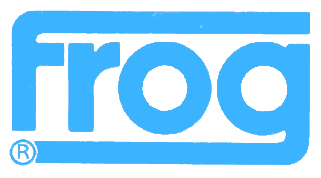
FROG Blue Series F182 Lockheed P-38J/L Lightning, Rovex Models & Hobbies Ltd, 1976
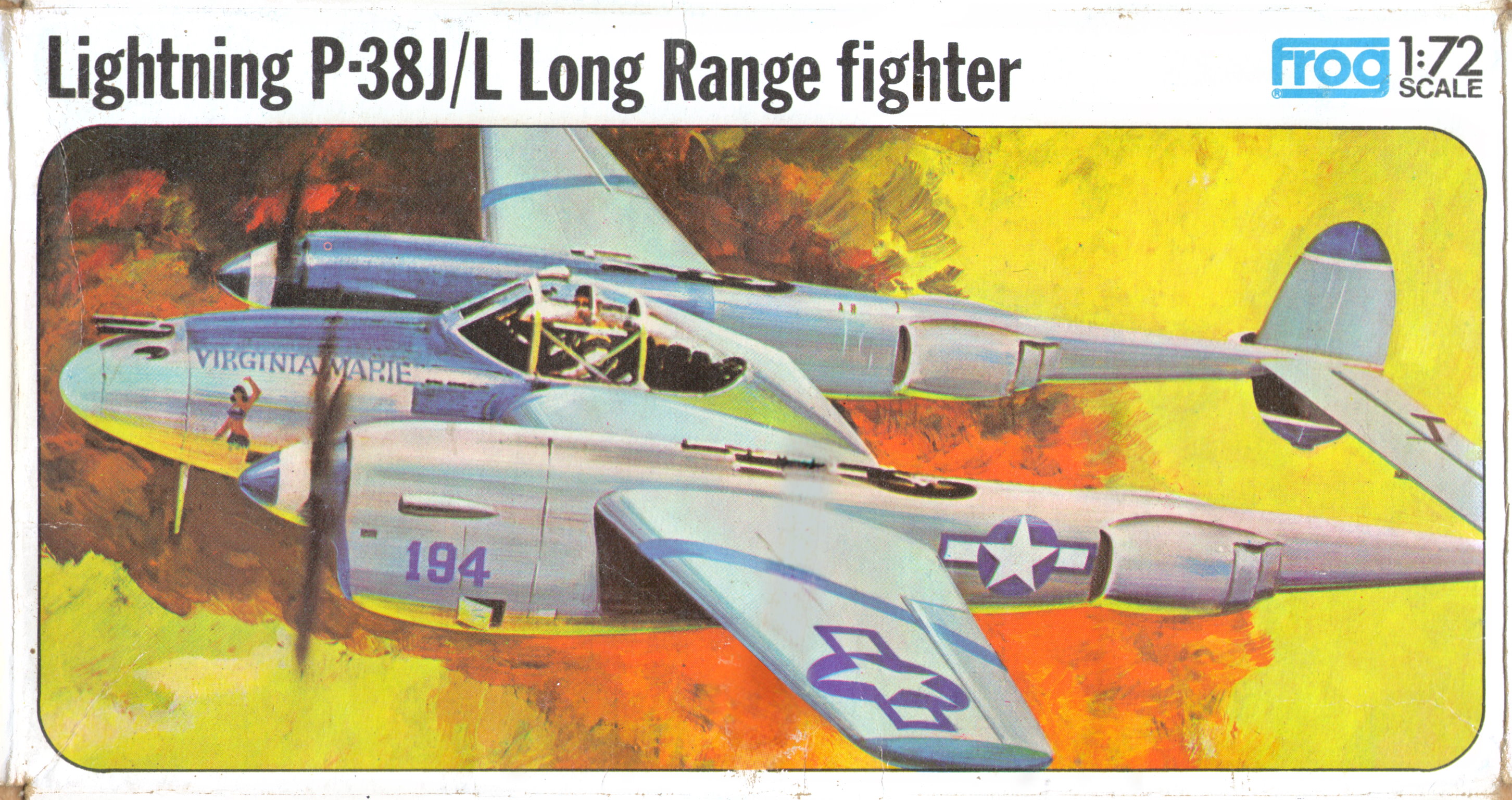
|
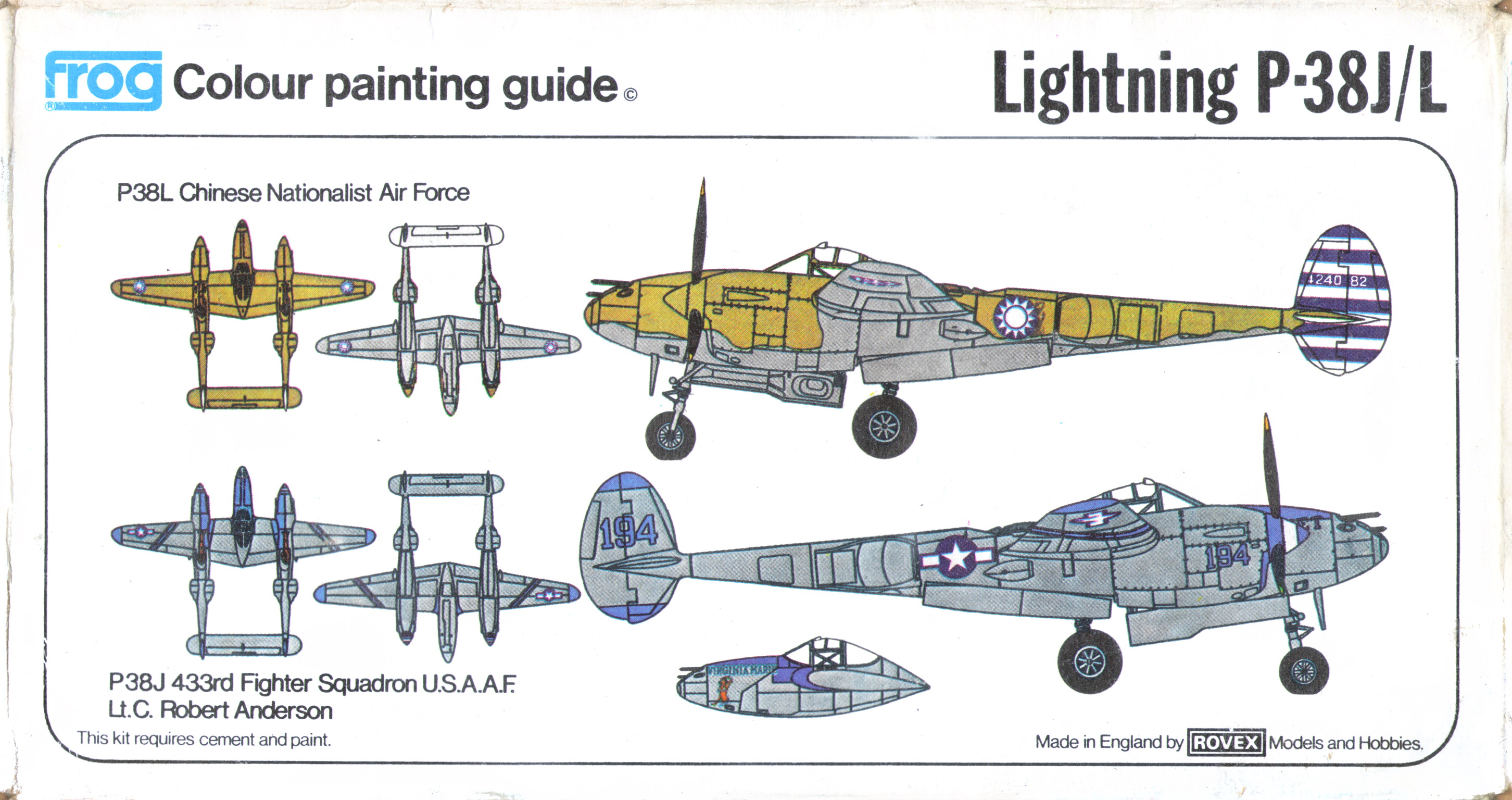


|
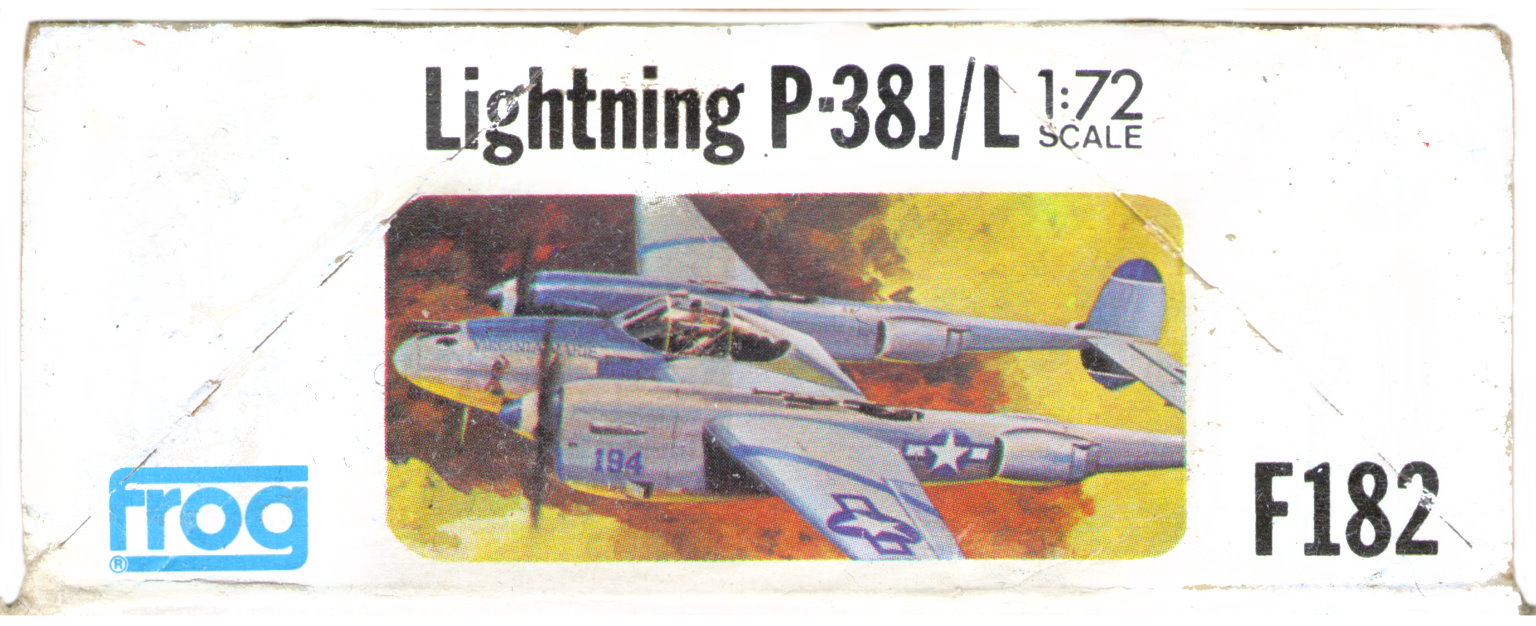
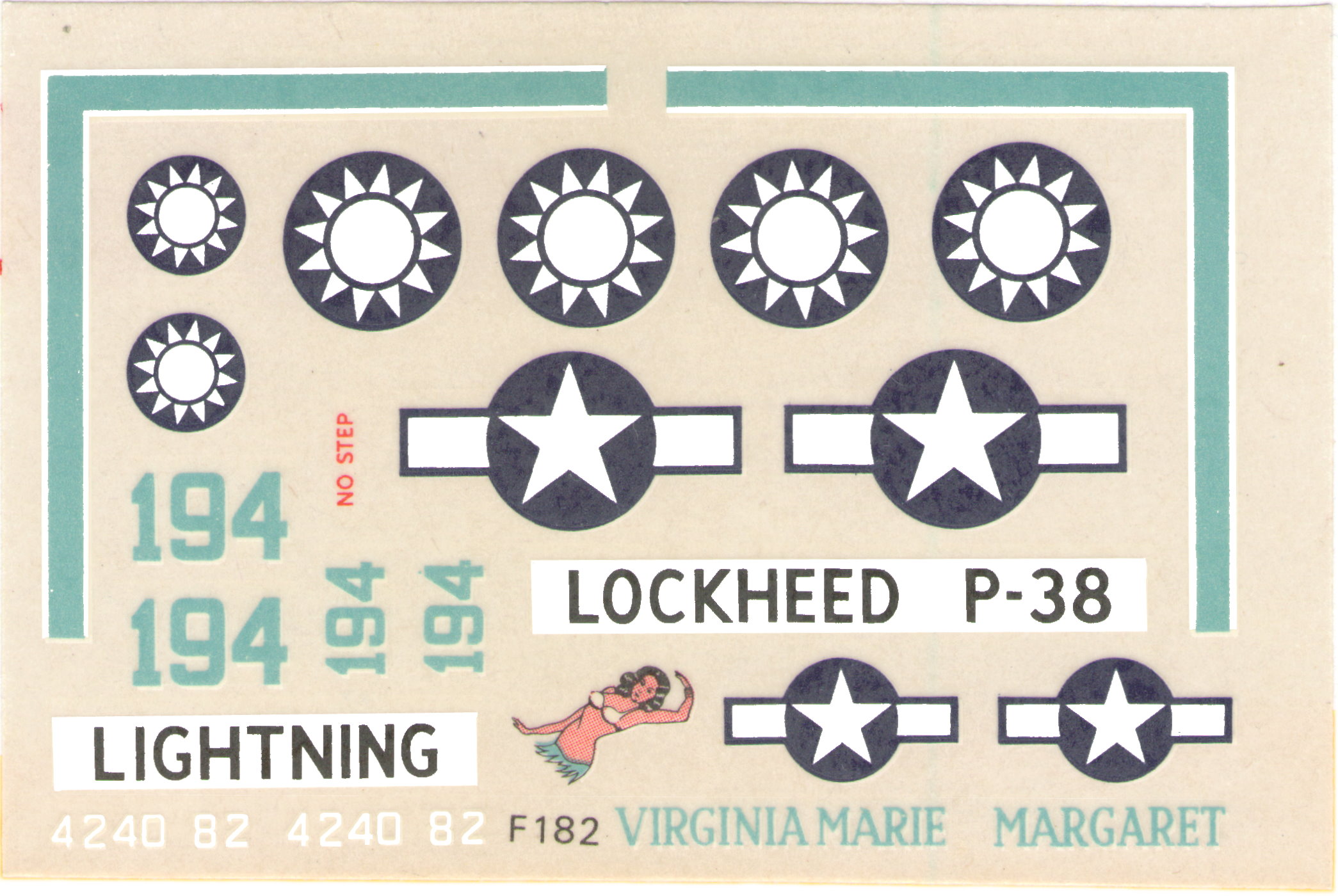



Lockheed P-38J/L Lightning
| F182 | 1976-1977 | H(B) | 20 000 | 1xUSAAF & 1xNatCh AF |
FROG model aircraft 1932-1976, R. Lines, L. Hellstrom
|
|
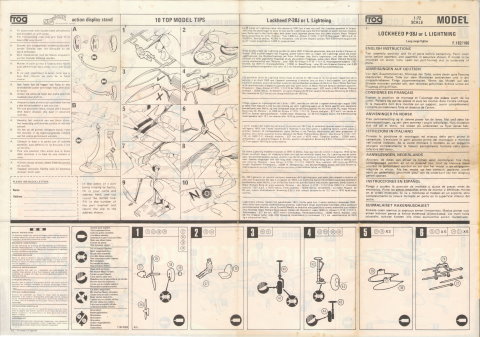
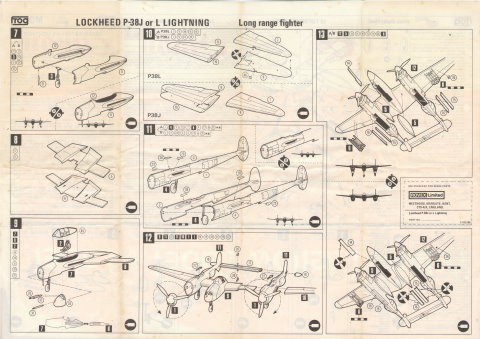
|
Novo Cat.No.78072 Lockheed P-38J/L Lightning, Novo Toys Ltd., 1980
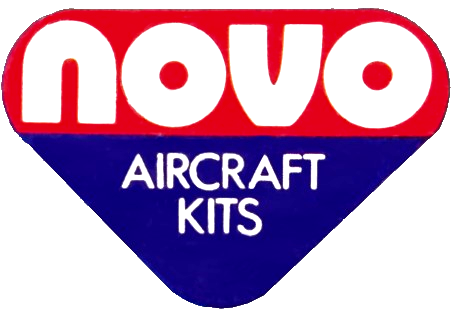
Novo
Novo Toys Ltd., Maxey, Peterborough, England PE69HQ
Period: 1976-1981
Few, if any other kit companies have been subjected to as much rumour spreading, speculation and ill-informed guesswork as Novo. Neither has any other company name been so misused, and perhaps it is best to start by putting this straight.
As can be seen above, Novo was a British company, and it always was. Although the company name itself was derived from Novoexport, their Soviet trade partner, Novo was never owned by the Russians. In recent years, Novo has been used as a collective name for any ex-Frog kits coming out of the USSR, but nothing could be more wrong or misleading. Only kits actually packed in Novo packaging should be called Novo kits. Anything else can only be described as kits by the Soviet factory in question (BFI, Krugozor, Tashigrushka etc.). If a collective name is really necessary, then one might perhaps use MLI (for the Soviet Ministry of Light Industry, who supervise most of these factories).
The events leading up to the creation of Novo have been covered in the Frog history section of this book and will not be repeated here. Suffice to say that a General Agreement was reached between Dunbee-Combex-Marx (the owner of both Novo and Rovex) and V/O Novoexport in August 1975. This agreement stipulated that DCM was to deliver moulds, tools and materials to Novoexport, who would pay for them by sending back finished goods from the same moulds. It must be pointed out that apart from model kits the agreement also covered a wide range of other toys. Novo Toys Ltd. was set up by DCM in 1975 to handle this business.
The finer details of the arrangement were set out in twelve contracts, three of which concerned the ex-Frog kits. A theoretical value (based on remaining production life and other factors) was set for each mould. These were totalled for each contract and a suitable mix of kits to the same amount was worked out, meaning that payment for a particular mould did not necessarily consist of kits from that very same mould only.
Once the agreed quantity of kits had been delivered by Novoexport, the moulds were considered their property and all future purchases by Novo had to be paid for in cash. In the event, no such follow-up orders were ever placed by Novo.
The first moulds were sent out to the USSR in early 1976 (i.e. almost a year before Frog production by Rovex finally ceased) and these were distributed among the several Soviet factories undertaking the actual production. With the exception of the Dennis Ambulance, Firefly Dinghy and the Axis aircraft sold to Revell, all Frog moulds still with Rovex in 1976 were shipped to the Soviet Union over the next year or so. Of these, the Britannia, R-100 and the car kits were considered to be of little interest to the Western market, and consequently no Novo numbers were ever assigned. Although not specifically mentioned in any contract, it is believed that the Soviets also took delivery of the old Drifter and Tug Boat moulds.
The Novo kit number incorporated the original projected year of release (e.g. 76001). Some kits were in fact delivered to Novo in 1976, but not until 1977 was a marketable range available and released. Due to this, no additional kits were planned for 1977, but instead delayed until 1978 and given numbers starting with 78. The many gaps in the sequence were partly filled by other Novo products.
Getting the Russians to keep up with the delivery schedule was the main Novo headache. From the very start and until the very end, Novoexport were constantly behind in their deliveries. The reasons were of course many, but a few of these warrant some comments.
Problems with production facilities and moulds were common. Although certain Soviet factories were fairly well-equipped, others had obsolete and unsuitable machinery. Staff competence and maintenance levels also sometimes left something to be desired. This not only slowed down production, but also led to some moulds being damaged. The Mirage mould, for example, was left out-doors one winter and was of course thoroughly rusty by spring! (It was later restored to usable condition.)
The mould for the old Typhoon, when returned to the UK for repairs, was found to be missing all six original locking bolts holding the two halves together. These had been replaced by four new ones of inferior material. Had these broken during operation (remembering that plastic was being injected with a pressure of over 500 p.s.i., or 35 kp/cm2), the mould would probably have been completely destroyed along with the injection machine and its unfortunate operator. The same mould had also been repaired by the Russians, using brass instead of toughened steel.
All in all, Novoexport complained about problems with some two dozen moulds. Of the eight subsequently repaired in the U.K., five had damage caused by the Russians.
But the main problem was the inferior plastic used in the USSR. All Frog moulds were tuned to use Shell SI73 polystyrene (or equivalent), having a Melt Flow Index of 35. Soviet polystyrene, on the other hand, was found to have an index of around 4! This meant that, in order to make the plastic fill the mould, the temperature had to be increased by some 50°C and the injection pressure up to 100%. Not only was this very damaging to the moulds (several subsequently had to be repaired), but also often led to sub-standard mouldings. This since the extreme pressure forced the mould halves apart, letting plastic overflow into the gaps and form flash.
Neither was the low MFI the only problem with the plastic. An independent evaluation carried out in 1978 reads like a catalogue of faults: "Izod (= impact strength) very low .. . abnormally low I.V. (= inherent viscosity) . .. colour is poor and contamination excessive ... poor surface finish and gloss ... extremely brittle and not very rigid .. . must make good colouring difficult and appearance of finished article to be doubtful quality."
The third major problem was politics. Soviet laws take a pretty grim view of anything "fascist", which was why all German, Italian and Japanese aircraft were sold to Revell instead of being sent to the USSR. But other problems were to come up.
The original boxes for the Tupolev SB-2 showed one Luftwaffe marking alternative. Novoexport refused point-blank to touch these and Novo eventually had to print a replacement batch of some 105,000 box bottoms. The Luftwaffe portion of the decals were also cut away.
Later on, the Soviet Ministry of Culture classed the Fokker D.XXI as a "fascist aircraft" since it had been used by the Finnish AF in WWII. The fact that the Finns also used e.g. M.S.406, P-40, Lysander, SB-2, Hurricane, Gladiator and Blenheim - all of which were also included in the Novo range - did not seem to bother them, however. Subsequent Novo attempts to get this decision changed were all in vain. It should be noted that Novo had replaced the original Finish AF marking alternative with a Danish one, to avoid this very problem.
The next casualty was the Sea Fury. Due to a slip-up, the 1980 Novo catalogue described it as having shot down some MiG-15s during the Korean War. Novoexport were much upset by this and refused to deliver any more Sea Fury kits! Only a few kits from an earlier trial consignment ever reached the market. The same fate probably befell the Sea Venom, only this time the catalogue mentioned Egyptian MiGs destroyed in 1956. Only a small number of Sea Venoms were delivered, anyway.
Despite all difficulties, business was good for Novo and their kits sold well - mainly due to very competitive prices made possible by the unique set-up of the production. The downfall of Novo was thus not caused by economical problems as has often been suggested, at least not directly. However, Dunbee-Combex-Marx Ltd. fell into severe financial difficulties in 1979 and eventually had to go into receivership. Since DCM owned Novo, legal requirements forced Novo to do the same and the company passed into the hands of the receivers in February 1980. No buyer could be found in time and Novo Toys Ltd. was wound up later in the same year, although formal liquidation only took place five years later.
The last Soviet deliveries were made in mid-1980 and all kits had been sold out by early 1981. Remaining stocks of boxes, decals and instruction sheets (all printed in the UK) were handed over to Novoexport together with some original box artwork and other bits and pieces.
Box styles, artwork, decals and instructions were in general very similar to the late Frog issues. Indeed, early box mock-ups were almost identical to the Frog boxes except for the removal of the Frog logotype. Apart from the mock-ups, a small batch of similar test boxes were also printed before the style eventually used was finally agreed upon.
Although most Novo kits were boxed, it should be pointed out that kits 76001-76031 were packed in plastic bags with header cards.
Apart from box style, there were also some changes in artwork and decal sheets. Sixteen of the kits used completely new box top art and a few others had slightly changed versions of the Frog originals. In addition, five kits used art previously only utilised on Air Lines boxes.
The only all-new decals were those for the Dart Herald, F-82, Baltimore, VC10 and Boeing 707, although the first three probably had the new designs completed while still with Rovex. Either way, the design work was carried out by Dick Ward of Modeldecal. Apart from the previously mentioned Tupolev and Fokker, the only other known change was that the P-38 had its Chinese markings alternative replaced by a second USAAF one. Although the HMS Trafalgar box art showed the ship with the "RO9" pendant number of HMS Cadiz, the actual decals gave "D77" which was the post-war number of Trafalgar.
A great deal of speculation has taken place over the last few years as regards which kits Novo actually released. And this with some right, since it is indeed a very complex subject.
To begin with, a large number of kits were undeniably released. The kit listing which follows gives production quantities for these.
Secondly, certain kits belonging to the third phase of the third contract were definitely never released. They arc all marked "t" in the list, and for these kits no boxes, decals or instruction sheets were ever printed.
This leaves us with some twenty-three kits which were never officially released but nevertheless had all boxes etc. printed. In the list they all have the official production quantity zero. Regrettably, this does not represent the whole truth, and that for two reasons.
The first one is that trial consignments were often received by Novo and, although not included in the official production quantity, these kits were eventually sold by them. It is also possible that a few batches of slightly faulty and previously rejected kits were also sold out at a discount when Novo closed down. These consignments might number anything from a few dozen to several hundred kits, in some case perhaps more than a thousand.
In connection with this, the Boeing 707 is a special case worth mention. A batch of some 3,000 707s were received by Novo and quickly distributed. However, it was soon found that most kits suffered moulding defects and in the end all but a very few were recalled by Novo or returned to them by irate buyers.
The second reason is that when Novo closed down, Novoexport held enough "paper work" to produce another 2,750,000 Novo kits. It is a fact that some of this has since been used by the Russians. In many cases only the box has been used, omitting the decals and substituting the instruction sheet with a Russian one (or a photo-copy of the Novo original). But sometimes all three original items have been used and the only clue that these are "fake" Novo kits might be the somewhat odd plastic colour (Novo usually managed to avoid the more disgusting ones of the strange shades apparently beloved by Soviet plastic producers). However, in a few cases even this gives nothing away. Since these kits are produced in the same factories as before, using original Novo boxes, decals and instruction sheets, they are - for all practical purposes - Novo kits.
To give some (admittedly subjective) indication of the quantity known to exist of the "zero production" kits, one or two pluses have been added. Thus "0+ + " indicates that a reasonable quantity - perhaps a few hundred - has found its way on to the Western market. "0+" indicates that very-few, or none, have yet been seen. But this may of course change at any time; who knows when the Soviets decide to make use of their 46,000 sets of Twin Mustang packaging...
Finally, the four Russian aircraft - Anatra, MiG-3, LaGG-3 and Yak-3 - must also be mentioned. Produced by Rovcx in accordance with the 1975 DCM-Novoexport agreement, the moulds were kept with Novo in England for many years. But for various reasons they were never included in any of the actual contracts with Novoexport, nor were kit numbers assigned. When Novo closed down, the Russians were most interested in buying the moulds but lacked the hard currency needed. Later attempts by the receivers to sell them to other kit manufacturers - including Lindberg, Monogram, Revell and Starfix - all failed. Not until 1983 were they finally disposed of, to Red Star (which see).
Throughout the list, the Novo number has been given as kit number. But all the kits also carried the old Frog number on the box; indeed, on the 76xxx kits this was more prominently displayed than the Novo number.
| | Qty |
| | 78072 | Lockheed P-38J/L Lightning | 0++ |
** Existence possible, information uncertain
FROG model aircraft 1932-1976, R. Lines, L. Hellstrom
|
|
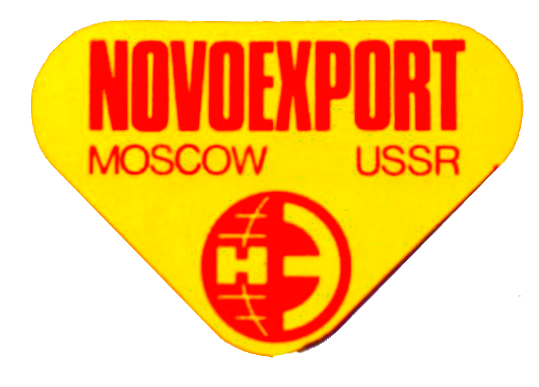
Novoexport Cat.No.78072 Lockheed P-38J/L Lightning, V/O Novoexport, not issued
Novoexport
V/O Novoexport, Bashitovskaya 19. Moscow 103287, USSR
Period: (1976 to date)
Novoexport is one of several state-owned Soviet export organisations, each specialising in a different type of merchandise, with Novoexport handling all sales of toys and similar goods.
Apart from the role played in connection with Novo (which see), Novoexport also had - and probably still has -an ambition to export kits produced from the old Frog moulds under their own name.
The first attempt took place in the mid-1970s, parallel to the introduction of Novo kits. Novoexport expressed a desire to export kits under their own name while simultaneously supplying kits to Novo. Novo had no objections and helped print a test batch of some 2,000 pieces each of fifteen header cards. No new instruction sheets were made, however. The cards were basically identical to those used by Novo, but with a red rather than blue border and a new logotype. However, Novoexport soon fell behind with their deliveries to Novo and, to ensure that no part of the Soviet production was diverted to other outlets, Novo refused to supply further header cards. The initial batch was never used commercially, but some cards have since surfaced from east Europe with Novo instructions and newly produced kits.
Attempt number two was initiated in September 1982, when contact was established with Capital Model Supply, a London hobby shop since gone bankrupt. After lengthy discussions a range of 24 kits was agreed upon (although the 1/96 scale Lancaster was later dropped) and by August 1984 a contract - giving CMS exclusive distribution rights -had been drawn up. However, at this point the financiers finally became aware of the true economic situation of CMS and consequently pulled out - only 48 hours before the contract with Novoexport was due to be signed!
Since no instruction sheets were printed for the first group, these kits have also been marked as projects only.
The observant reader will have noted that the last nine kits in the second group have numbers different from the Novo issues. These numbers are shown on a recent Soviet list and would in all probability have been used on the kits in question, had they been released.
2nd group
| + | 78072 | Lockheed P-38J/L Lightning |
FROG model aircraft 1932-1976, R. Lines, L. Hellstrom
|
|
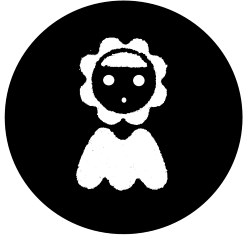
«Escort fighter»; 4777-BL; Minsk Industrial Union for Toy Production "Mir", 80 - 90-s
«Истребитель сопровождения», 4777-БЛ; Минское производственное объединение по выпуску игрушек "Мир", 80-ые
1981
|
|
Z4.11.Z0ZZ
|
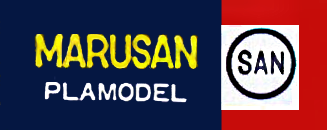
Marusan P-38L Lightning
|
|
|
|
New kits and models
SMALL SCALE FROM JAPAN
FOR those aircraft modellers with 1:100 scale collections the news that Marusan, the Japanese manufacturer, has entered the market with a number of World War 2 kits in this scale will be welcome. Three kits are already in the UK and the manufacturers say that there are more to come. At present those available are a P-38L Lightning, Focke-Wulf Fw 190 and Yak-9P. A Hellcat, Shiden and Thunderbolt will be available later.
The kits available are fairly reasonable models. Rivet sizes are rather large and there will have to be one or two modifications made to the outline of the models if absolute accuracy is required. There are no gimmicks. Each kit retails from BMW Models (who supplied our samples) for 2s 6d.
A.W.H.
Airfix magazine August 1965 Vol.6 No.12
MODELLING
W. R. MATTHEWS
Offerings from the Orient
ALLIED TYPES PRODUCED IN JAPAN
Needless to say, Japanese kit manufacturers do not confine themselves to models of indigenous aircraft. Kogure has recently issued an excellent 1/48th scale plated kit of one of the most formidable of Japan's wartime opponents, the P-51D Mustang. Like the D4Y1, this was also issued originally as a transparent model. It is motorised, the batteries for the motor being housed in a model petrol bowser, the plating is excellent and varies in brightness to represent panel detail, and the transfer sheet is also of a very high standard. To add a little variety, this sheet gives the markings of a Mustang in post-war USAF service. Two other models of wartime Allied fighters, the Spitfire IX and the P-38L Lightning, both to 1/48th scale from Marusan, bear a remarkably close similarity to kits of these aircraft issued in the USA by Monogram and Aurora respectively. However, the transfer sheets issued with these kits are certainly original, and, in the case of the Spitfire, inaccurate—the markings are those for a Spitfire VB, and the fuselage letters should be grey and not pale blue.
RAF Flying Review July, 1965, Vol. XX, No. 11
|
|
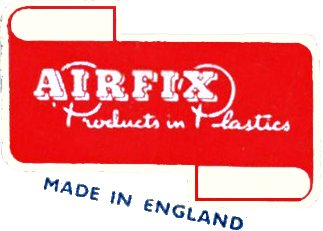
AIRFIX Series 2 1402, (02004-8) Lockheed P-38 Lightning, 1958
|
|
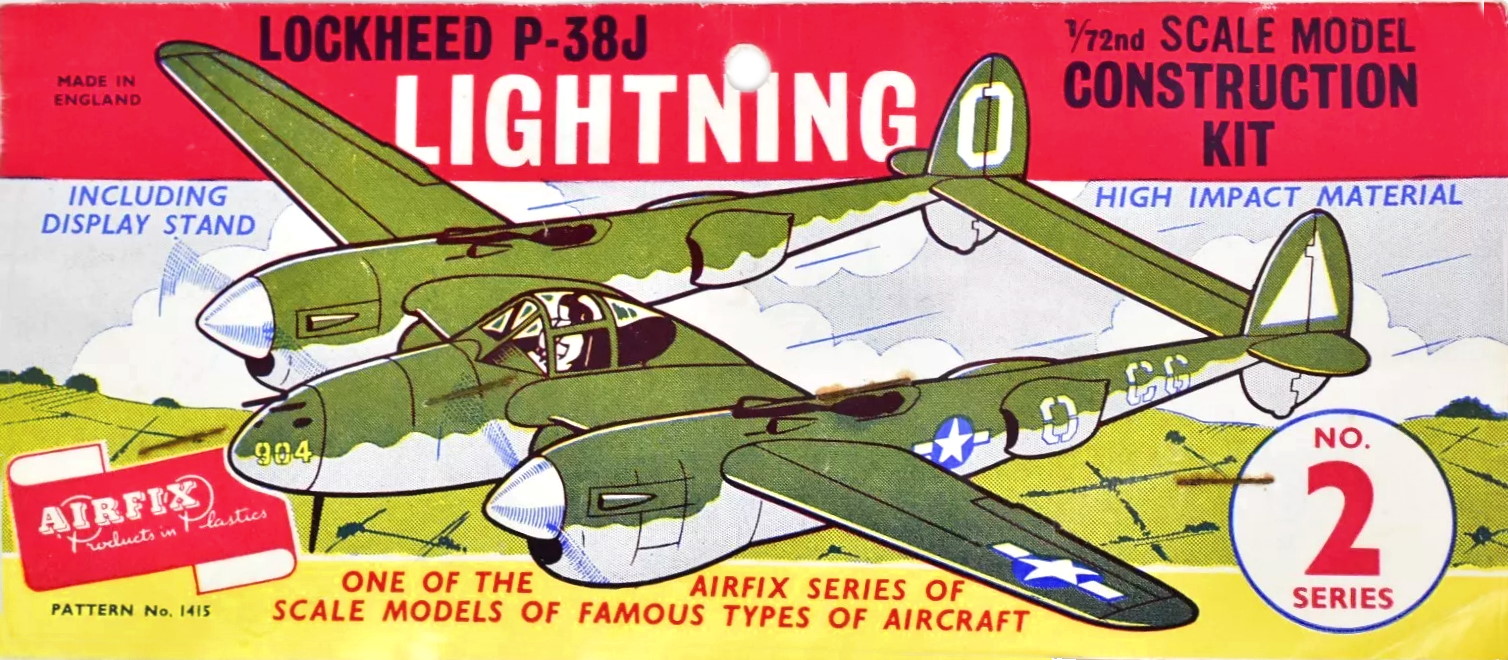
|
TRADE NOTES
New plastics from Airfix in their Series 2 range at 3s. each retain the popular 1/72nd scale and cover two of the great World War II twin-engined favourites, the Bristol Beaufighter and the twin-boom Lockheed I lightning. No less than 55 pieces go to make the finished Beaufighter T.F.X., Single-engined types new to the Series 1 Aitfix range are the long-nosed Focke-Wulf 190D and Douglas A4D-1 Skyhawk at 2s. each.
AeroModeller OCTOBER 1958 VOLUME XXIII NUMBER 273
MODEL TALK by GEOFFREY NORRIS
AIRBORNE MODELLING: Modification to my statement of two months ago that Stirling Moss was the first person to build a model while airborne—Mr. Shane Norman, of Ampleforth, Yorkshire, writes to say that he built an Airfix Lockheed Lightning while flying between Manchester and Dublin in a Fokker Friendship of Aer Lingus in May, 1959. Now let's hear from someone who built an old Frog Penguin kit in a Handley Page Hannibal. . . .
RAF Flying Review August, 1960, Vol. XV, No. 12
|
|

AIRFIX Series 3 398, (03018-0) Lockheed P-38E/F Lightning, 1973
|
|
|
|
MODEL ENTHUSIAST
Catering for the collection
... and others from Heller and Airfix
The WW II aircraft model addicts have been particularly well catered for recently as, in addition to the previously-mentioned Frog offerings, we have received ... Airfix's Lockheed P-38F Lightning, also to 1/72nd scale.
The latest of Airfix's replacement kits to be received depicts the Lockheed Lightning, and is particularly welcome in that it represents the first truly operational variant, the P-38F, whereas all other available kits are of the later P-38J. Airfix has performed a fine job on this kit which assembles well and produces a model which is accurate in outline. Particularly commendable points are the neat undercarriage details and the sharp moulding of the turbo-supercharger parts on top of the tailbooms. The rivet detail is not too pronounced, especially after painting, and the decals are matt and of fair quality. Markings are provided for an aircraft of the USAAF's 347th Fighter Group on Guadalcanal in February 1943, complete with "Shark's mouth" insignia, and for an aircraft of the 14th Fighter Group in Algeria in 1942, both aircraft sporting the standard olive drab and grey finish. After the less-than-satisfactory Hurricane produced by Airfix recently, the P-38F Lightning comes as a reminder that this company can still offer 1/72nd scale kits to match the best. The UK price of this kit is 35p and good value at that.
F J HENDERSON
Air Enthusiast 1973-01 vol.04 no.01
KIT COMMENT
EARLY LIGHTNING FROM AIRFIX
Latest addition to the Airfix Series 3 range is the Lockheed P-38F, the first true operational version of the famous Lightning. The 67-part kit comes in the markings of a US unit on Guadalcanal early in 1943, complete with sharkmouth nacelle decals. Wingspan is 8½ ins. and the length 6 ins.
As all the other 1:72nd scale models of the P-38 depict the later T model, this kit will be welcomed by many. Surface detailing, although riveted, is light enough not to detract from scale accuracy. Overall appearance of the finished model is pleasing and it can, of course, be finished in a variety of markings and colour schemes, including that of an L-322 of the RAF, which differed only in minor details. The more ambitious could modify the nose section to make an F-5A in French or US markings.
The supercharger detail on top of each nacelle is particularly well done, as are the undercarriage legs, machine guns and tailplane mass balances. Two underwing drop tanks also come with the kit, which is priced at 35p.
Aviation News Vol 1 Num 10 29 September - 12 October 1972
NEW AND IN VIEW
AIRFIX PRODUCTS LTD. Lockheed P.38F. Lightning. 1/72 scale. Series 3
As the only available kit of the Early mark P-38 this fine model provides an excellent basis also for conversion to other marks such as F-4/F-5s and fighter Gs etc.
Moulded in medium grey plastic there is rather a lot of surface detail (a surfeit rather than too heavy detail). The fit of parts is very good particularly that of the booms and fuselage. The undercart is finely moulded with the necessary struts well represented.
Canopy is clear and well defined with correct framing including break out panel and landing and ident. lights are included.
The only major fault is the boom air intakes which are too small and wrong shape. The box art shows the correct shape and the Kookaburra 'Lockheed P-38 Lightning' by Roy Cross provides a most useful reference together with Camouflage and Markings series No. 18.
These two publications cover all P-38 variants with a wealth of data on camouflage and markings and aircraft detail.
Kit decals are for a P-38F of the 48FS/14FG (Code ES) and a Shark mouth Pacific based P-38F 'S.33'. This decals are a particularly good fit.
Humbrol O.D.41 and Neutral Grey 43 are accurate for both these A/C while the blue spinner tips of the 14FG can be obtained by matting Humbrol gloss Mediterranean Blue 48. Interior Green for the cockpit (ANA 6110) and oleos etc. in silver.
The IPMS magazine, NOVEMBER 1972. Vol. 9 No. 11
|
|

Matchbox PK-118 Lockheed P-38J Lightning, Lesney Products & Co Ltd., 1977
|
|
|
|
MODEL ENTHUSIAST
The twin-tailed Lightning
Lockheed's P-38 Lightning has never lacked for admirers among the modelling fraternity, or, for that matter, among the kit manufacturers. The P-38 made its debut in kit form about a quarter-century ago, when Aurora first offered a 1/48th scale kit which was to be surpassed many years later by an excellent Monogram product to the same scale. Even larger is a fine 1/32nd scale kit by Revell and there have been some odd-scale early efforts from various Japanese manufacturers. In 1/72nd scale, Airfix was first in the field with a P-38J which this company supplemented very much later with a fine P-38F, while Frog, in the meantime, had also produced a P-38J. Oddly enough, over all this time no US company offered a Lightning in 1/72nd scale, although we understand that Revell is now planning to produce one. Now we have yet another P-38J produced in the UK, but this one, which is being offered by Lesney in its well-known 'Matchbox' range, offers alternative markings to permit completion as a P-38L.
This kit is typical of recent 'Matchbox' standards, with perfectly flash-free mouldings in beige, mid-green, black and clear plastic, and comprising 75 component parts in all. The kit is not to be faulted on the score of outline accuracy, the parts fit together with commendable precision and the surface detailing, admittedly somewhat coarse, is acceptable once a couple of coats of paint have been applied. All of the required details are provided, including separately-moulded turbo-superchargers, elevator mass balances and underwing racks for 10 rocket projectiles. Sadly, while provided with a good, clear canopy with neatly engraved framing, a floor, a nondescript-pattern seat and a pilot figure, the cockpit lacks everything else.
Weighting the nose presents something of a problem as the model is most decidedly tail-heavy and we concluded that lead shot is the best solution as it enables a good concentration of weight to be achieved in the limited space available. The P-38J and P-38L versions of the Lightning were, of course, externally virtually identical, and the kit makes no differentiation between them apart from markings and colour schemes, and the alternatives offered are an olive drab and neutral grey P-38J of the 343rd Sqdn, 55th Fighter Group, 8th Air Force, based in the UK in 1943-44, and a natural metal P-38L of the 431st Sqdn, 475th Fighter Group, operating from New Guinea in October 1944. The decal sheet is adequate without being adventurously comprehensive, but retailing at 63p in the UK, this kit represents excellent value for money.
F J HENDERSON
Air Enthusiast 1977-06 vol.12 no.06
|
|
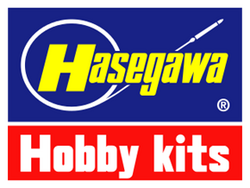
Hasegawa Lockheed P-38J Lightning, 1978
|
|
|
|
MODEL ENTHUSIAST
Lightning strikes yet again
Few types of WWII fighter have received more attention from the kit manufacturers than has Lockheed's P-38 Lightning. Yet another Lightning may seem superfluous to the modelling fraternity, but when it comes from a company of the status of Hasegawa, it is certain to be worth close examination, and this 1/72nd scale offering is one to get even if you already have two or three Lightnings.
Basically, this kit is for the P-38J version, although it may also be completed as a P-38L, which featured minor external differences and could tote rockets beneath its wings, or the earlier P-38F for which extra parts, including a separate canopy and different cowling sections are provided, although the last-mentioned sub-type demands the application of a certain amount of surgery, this being rendered as painless as possible by score marks moulded into the plastic parts. The kit comprises 64 parts, mostly moulded in dark green plastic, and these are of superb quality, free of blemish and sporting the finest of surface detailing.
The smaller parts, such as the undercarriage legs, are true to scale and very delicately formed, and the trailing edges of all flying surfaces are knife edged. The wheels are of correct pattern and and their tyres have clearly formed treads. Landing lights are included among the transparencies, different types being provided for all three Lightning subtypes. External stores include two drop tanks and two racks each with five rockets, the former for the P-38J and the latter for the P-38L. The predilection of P-38 models towards tail-sitting has prompted Hasegawa to provide a transparent prop for the tail. The cockpit interior is quite well furnished, but if the pilot figure is discarded some extra detail may be added with advantage.
The decals sheet provides markings for one example of each of the three sub-types and includes appropriate nose art. The P-38F was, operated by the 94th Squadron of the 1st Fighter Group (12th Air Force) in North Africa; the P-38J flew with the 38th Squadron of the 55th Fighter Group (8th Air Force) in Northern Europe, and the P-38L was Major George Laven's Itsy Bitsy of the 49th Fighter Group Headquarters Squadron based in the Philippines. All in all, this is a very fine kit.
F.J. Henderson
Air International 1978-02, Vol.14, No.2
NEW TO YOU?
KITS
Hasegawa
Lockheed P38 J/L or F Lightning. 1/72nd scale. Price £1.35.
Distributed by A.A. Hales Ltd.
LATEST addition to Hasegawa's fine range of 1/72nd scale warpianes if the famous "fork-tailed devil" and is a really ambitious production offering no less than three variants in one box. As one might expect the kit is finely moulded although a little flash was prevalent on our sample and the fit of parts was not quite up to Hasegawa's usual standard.
Construction is quite straightforward and while a 5 gram weight is recommended to keep the nose down, we found at least 6½ was required, and the undercarriage units are sufficiently sturdy to support the weight.
The P38F intakes are made up of four pieces and are fitted after cutting away a section of each nacelle, which is scored on the inside to facilitate removal. Care should be taken during this operation and again, filler will be required on some joints.
Cockpit detail is provided but lacks an instrument panel and control column, although consoles are provided - extra work is advised in this area as both styles of canopy are very thin and crystal clear. Fuel tanks and rockets a re supplied together with a transparent tail prop if weights are not installed by the modeller. Hasegawa have also taken care to point out the opposing direction of the propellers and these are carefully drawn so that there should be no slip-ups.
Decals are of fair quality and provide markings for a P38J of the 8th Air Force, 55th Combat Regiment, 33rd Squadron, a P38F of the 12th Air Force, 1st Combat Regiment, 94th Squadron, and a P38L of the 49th Combat Regiment Headquarters Squadron. Full painting guides for these aircraft are shown on the instruction sheet.
Alternative decals may be found on MicroScale sheet 72-172 which as well as Including instrument panels also features complete stencilling including propeller trademarks. Hasegawa are to be commended on this latest release and we look forward to their promised range of jets for 1978 issue.
ED
Scale Models Vol. 9 No. 101 February 1978
|
|
|